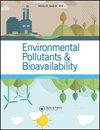Analysis of iodine and its species in animal tissues
Q3 Chemical Engineering
引用次数: 5
Abstract
Abstract A method allowing the determination of the total iodine content and iodine species in samples of animal tissues using inductively coupled plasma mass spectrometry (ICP-MS) as an element-specific detector was developed. The total iodine content was determined after microwave digestion with 25% (w/w) water solution of tetramethylammonium hydroxide. The detection limit was 26.9 μg kg−1 I, and the accuracy of the determination was proven through the analysis of SRM “Non-Fat Milk Powder,” porcine liver, and Atlantic Cod muscle samples using standard addition methods. The extracts for the speciation analysis were prepared through sample dispersion in water using an Ultra-Turrax® T10. The extraction yields ranged from 46 to 84% for different types of tissues. The determination of the inorganic iodine species was performed using ion-exchange chromatography (PRP X100, mobile phase 100 mmol L−1 ammonium nitrate, pH 7.4) coupled to ICP-MS. A detection limit of 1.1 μg kg−1 I was obtained for both species. The organic iodine species were separated using size-exclusion chromatography (Superdex 75 column, mobile phase 20 mmol L−1 Tris–HCl, pH 7.5) and also detected using ICP-MS. Samples of porcine muscle, liver, kidney and thyroid gland, chicken muscle and liver and Atlantic Cod muscle were analyzed. The porcine thyroid gland and Atlantic Cod muscle samples were the richest in iodine (a more than 10× greater content of iodine than the other samples). With respect to the inorganic species, only iodide was found in the sample extracts. Conversely, many organic iodine species were found in the extracts.动物组织中碘及其种类的分析
摘要建立了电感耦合等离子体质谱(ICP-MS)作为元素特异性检测器测定动物组织样品中碘的总含量和碘种的方法。用25% (w/w)的四甲基氢氧化铵水溶液微波消解后测定总碘含量。检测限为26.9 μg kg−1 I,采用标准添加法对SRM脱脂奶粉、猪肝和大西洋鳕鱼肌样品进行分析,验证了检测的准确性。通过Ultra-Turrax®T10在水中分散样品制备用于物种形成分析的提取物。对不同类型的组织,提取率从46%到84%不等。采用离子交换色谱法(PRP X100,流动相100 mmol L−1硝酸铵,pH 7.4)耦合ICP-MS测定无机碘。两种菌株的检出限均为1.1 μg kg−1 I。采用排阻色谱法(Superdex 75柱,流动相20 mmol L−1 Tris-HCl, pH 7.5)分离有机碘,并采用ICP-MS进行检测。对猪肌肉、肝脏、肾脏和甲状腺、鸡肌肉和肝脏以及大西洋鳕鱼肌肉进行了分析。猪甲状腺和大西洋鳕鱼肌肉样品碘含量最高(碘含量为其他样品的10倍以上)。对于无机物,样品提取物中只发现碘化物。相反,在提取物中发现了许多有机碘。
本文章由计算机程序翻译,如有差异,请以英文原文为准。
求助全文
约1分钟内获得全文
求助全文
来源期刊
CiteScore
1.62
自引率
0.00%
发文量
0
审稿时长
1 months
期刊介绍:
Chemical Speciation & Bioavailability ( CS&B) is a scholarly, peer-reviewed forum for insights on the chemical aspects of occurrence, distribution, transport, transformation, transfer, fate, and effects of substances in the environment and biota, and their impacts on the uptake of the substances by living organisms. Substances of interests include both beneficial and toxic ones, especially nutrients, heavy metals, persistent organic pollutants, and emerging contaminants, such as engineered nanomaterials, as well as pharmaceuticals and personal-care products as pollutants. It is the aim of this Journal to develop an international community of experienced colleagues to promote the research, discussion, review, and spread of information on chemical speciation and bioavailability, which is a topic of interest to researchers in many disciplines, including environmental, chemical, biological, food, medical, toxicology, and health sciences.
Key themes in the scope of the Journal include, but are not limited to, the following “6Ms”:
Methods for speciation analysis and the evaluation of bioavailability, especially the development, validation, and application of novel methods and techniques.
Media that sustain the processes of release, distribution, transformation, and transfer of chemical speciation; of particular interest are emerging contaminants, such as engineered nanomaterials, pharmaceuticals, and personal-care products.
Mobility of substance species in environment and biota, either spatially or temporally.
Matters that influence the chemical speciation and bioavailability, mainly environmentally relevant conditions.
Mechanisms that govern the transport, transformation, transfer, and fate of chemical speciation in the environment, and the biouptake of substances.
Models for the simulation of chemical speciation and bioavailability, and for the prediction of toxicity.
Chemical Speciation & Bioavailability is a fully open access journal. This means all submitted articles will, if accepted, be available for anyone to read, anywhere, at any time. immediately on publication. There are no charges for submission to this journal.

 求助内容:
求助内容: 应助结果提醒方式:
应助结果提醒方式:


